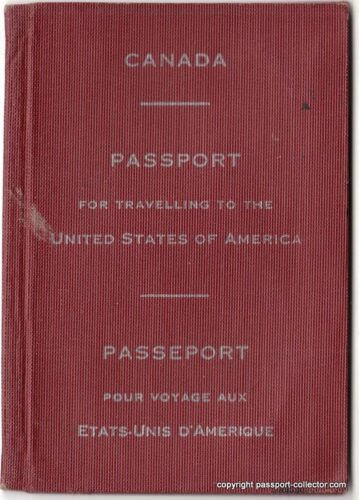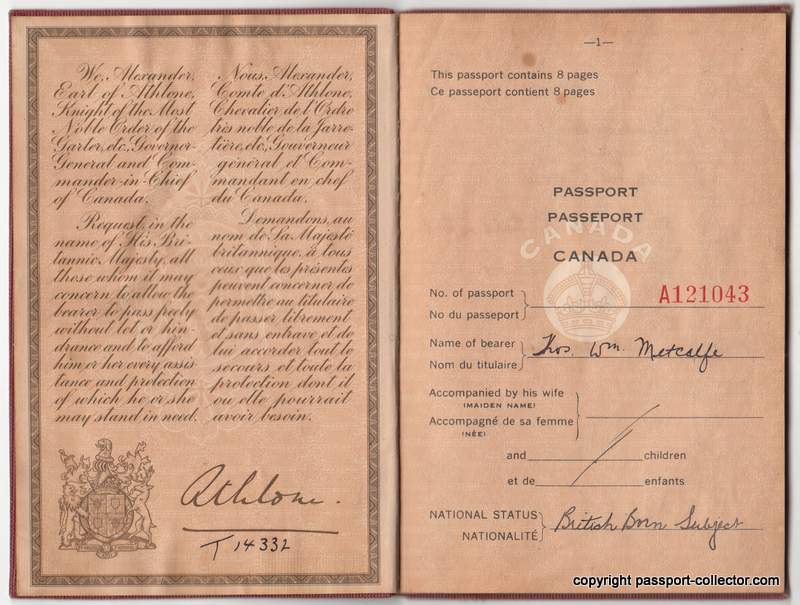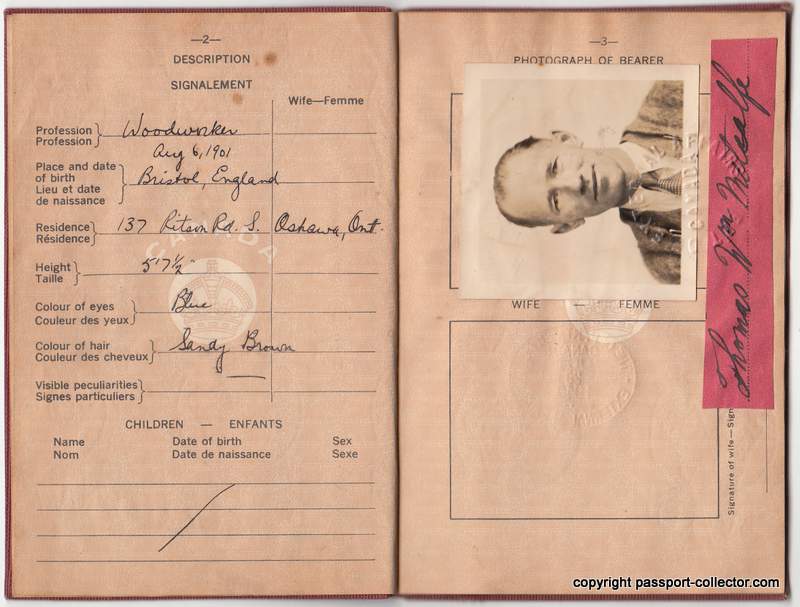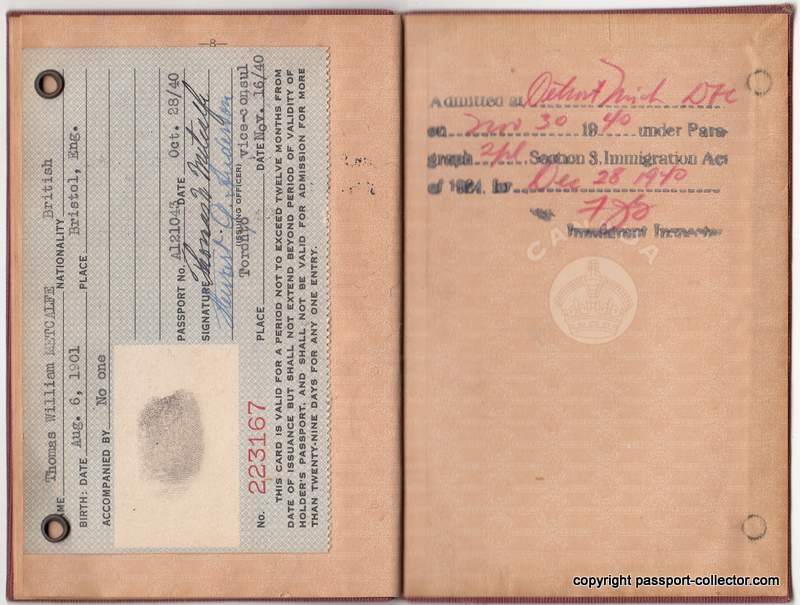Canada passport for USA travel only
 Reacting to potential threats to its security
Reacting to potential threats to its security
the US government announced on June 6, 1940, that Canadians would require passports and visas to enter the US as of the first of the following month. Ottawa reacted quickly by expanding the passport staff to 113, setting up additional offices, and creating a special eight-page passport specifically for those traveling to Canada’s southern neighbor. Canada passport USA travel
The development of the Canadian passport
is part of a much longer history that also intertwines with that of the British Empire. Although documents providing the bearer with permission to travel either inside or outside a political entity have long existed, the first systematic use of passports began in France in the era of the Revolution. Initially, the passport was an effort to control the movement of people within France and, as such, aided the police force in its efforts to keep track of those deemed a threat to the state.
Next, the new revolutionary assembly brought in a requirement that merchants and foreigners seeking to leave the country had to obtain passports from their local districts in the case of the former and the ambassadors of their countries of origin in the case of the latter. However, for some in the revolutionary assembly, the passport remained a controversial and repressive measure.
For example, well into the late 1940s, married women in Canada were not allowed their passports, but, like children, they had to be included in their husband’s documents. In an authentic sense, the passport has never been a neutral document. The final essential inspiration for the modern passport era was World War I. Before the war, severe international discussions about moving toward eliminating passports had occurred.
The conflict’s outbreak quashed these efforts as several countries, including the United States and the United Kingdom, dramatically tightened documentary requirements. In the latter case, the requirement that British citizens carry identity cards was enacted.
Brief Canadian Passport History Canada passport USA travel
The story of the Canadian passport is entwined with Canada’s history, both as a colony of Great Britain and as a neighbor of the United States.
Before 1862
Canadians, as British subjects, could travel freely to and from the United States without passports. To travel to Europe, however, a Canadian had to obtain a British passport from the Foreign Office in London. Those who were not British subjects by birth could still go to the United States with a certificate of naturalization, which was issued by local Canadian mayors, mainly for voting in municipal elections.
During the American Civil War
however, authorities in the United States wanted more reliable certification from people living in Canada. In 1862, the Governor-General, Viscount Monck, introduced a centralized system for issuing passports. For the next 50 years, a Canadian passport was a “letter of request” signed by the Governor-General.
It isn’t easy to trace the history of Canadian passports in the first few years after Confederation because so few were issued. The financial statements of the Secretary of State in 1878 record an annual passport revenue of $50. Since passports then cost $1 each, we know 50 must have been issued. Over the next few years, annual revenues varied between $35 and $50. Canada passport USA travel
Early years
In those early years, passports were issued as single-sheet certificates and stamped with the official seal. In 1915, Canada switched to the British form, a ten-section single sheet folder printed in English only.
A series of international passport conferences (1920, 1926, and 1947) led to several changes to the Canadian passport. The 1920 conference recommended that all countries adopt a booklet-type passport, which Canada began issuing in 1921. Another recommendation of 1920 that all passports were to be written in at least two languages, one of which was French, led to the first bilingual Canadian passport in 1926.
The 1920 conference also recommended that passports be valid for at least two years, and preferably for five. It is interesting to note that, since 1919, Canadian peacetime passports were already valid for five years, with the possibility of a five-year extension.
Passport Applications Only In Ottawa Canada passport USA travel
Between 1947 and 1970, Canadians could only apply for passports by mail to Ottawa. Requirements were elementary, and applicants claiming birth in Canada did not have proof. However, the increased number of lost and stolen passports pointed to tighten requirements within a few years. This need was reinforced by the escape of James Earl Ray, the assassin of Martin Luther King Jr., using a fraudulently-obtained Canadian passport. Canada passport USA travel
The Royal Commission on Security in 1969 recommended much more stringent application requirements. It also supported plans to open Passport Canada offices across Canada for better service to the public. In 1970, three Passport Canada offices opened—in Montreal, Toronto, and Vancouver—to accept and process applications submitted in person. There are now 34 offices across Canada, processing more than 70 percent of the over 4 million Canadian passports issued each year (2014).
Machine-readable passports
were introduced in Canada in 1985 to meet the International Civil Aviation Organization (ICAO) regulations. The new format was smaller, and the bearer’s personal information, photograph, and passport details were laminated to prevent tampering. In the special machine-readable zone, personal information and passport details were repeated in a format scanned at checkpoints.
In 1991, additional security features were built into the Canadian passport, and more stringent processing requirements were put in place. By 1993, a new passport style was introduced with unique features to prevent replication or alteration. To protect the passport’s integrity and remain current with global security technology, Canada is a regular participant at ICAO conferences and is recognized as a leader in technological developments in passport design and processing systems. Canada passport USA travel
At the turn of the century, Passport Canada invested in new technology to modernize its operations and create a more secure passport, introduced domestically in 2002 and abroad in 2006. This passport featured a digitally printed photo of the bearer embedded into the identification page of the booklet, holographic images, and a second hidden photo of the bearer that could only be viewed under ultraviolet light.
On July 1, 2013, Passport Canada started issuing a new, even more secure electronic passport, known as the ePassport. This new-generation passport has an electronic chip embedded in the book to provide more excellent protection against fraud and tampering and contribute to domestic and international travel security. From its simple beginnings as a letter of safe conduct, the passport has become the single most important international identity document a traveler can carry.
The Passport Canada passport USA travel
Issued to Thomas W. Metcalfe, a woodworker from Ottawa born in Bristol, England in 1901. Attached to his passport is a Non Alien’s Border Crossing Identification Card. A rare document of Canadian passport history.
Language: English/French
Pages: 8
Issued: 28 Oct 1940 and valid for one year
But the most rare Canadian passport you will see here…
FAQ Passport History
Passport collection, passport renewal, old passports for sale, vintage passport, emergency passport renewal, same day passport, passport application, pasaporte passeport паспорт 护照 パスポート جواز سفر पासपोर्ट
1. What are the earliest known examples of passports, and how have they evolved?
The word "passport" came up only in the mid 15th Century. Before that, such documents were safe conducts, recommendations or protection letters. On a practical aspect, the earliest passport I have seen was from the mid 16th Century. Read more...
2. Are there any notable historical figures or personalities whose passports are highly sought after by collectors?
Every collector is doing well to define his collection focus, and yes, there are collectors looking for Celebrity passports and travel documents of historical figures like Winston Churchill, Brothers Grimm, Johann Wolfgang von Goethe. Read more...
3. How did passport designs and security features change throughout different periods in history, and what impact did these changes have on forgery prevention?
"Passports" before the 18th Century had a pure functional character. Security features were, in the best case, a watermark and a wax seal. Forgery, back then, was not an issue like it is nowadays. Only from the 1980s on, security features became a thing. A state-of-the-art passport nowadays has dozens of security features - visible and invisible. Some are known only by the security document printer itself. Read more...
4. What are some of the rarest and most valuable historical passports that have ever been sold or auctioned?
Lou Gehrig, Victor Tsoi, Marilyn Monroe, James Joyce, and Albert Einstein when it comes to the most expensive ones. Read more...
5. How do diplomatic passports differ from regular passports, and what makes them significant to collectors?
Such documents were often held by officials in high ranks, like ambassadors, consuls or special envoys. Furthermore, these travel documents are often frequently traveled. Hence, they hold a tapestry of stamps or visas. Partly from unusual places.
6. Can you provide insights into the stories behind specific historical passports that offer unique insights into past travel and migration trends?
A passport tells the story of its bearer and these stories can be everything - surprising, sad, vivid. Isabella Bird and her travels (1831-1904) or Mary Kingsley, a fearless Lady explorer.
7. What role did passports play during significant historical events, such as wartime travel restrictions or international treaties?
During war, a passport could have been a matter of life or death. Especially, when we are looking into WWII and the Holocaust. And yes, during that time, passports and similar documents were often forged to escape and save lives. Example...
8. How has the emergence of digital passports and biometric identification impacted the world of passport collecting?
Current modern passports having now often a sparkling, flashy design. This has mainly two reasons. 1. Improved security and 2. Displaying a countries' heritage, icons, and important figures or achievements. I can fully understand that those modern documents are wanted, especially by younger collectors.
9. Are there any specialized collections of passports, such as those from a specific country, era, or distinguished individuals?
Yes, the University of Western Sidney Library has e.g. a passport collection of the former prime minister Hon Edward Gough Whitlam and his wife Margaret. They are all diplomatic passports and I had the pleasure to apprise them. I hold e.g. a collection of almost all types of the German Empire passports (only 2 types are still missing). Also, my East German passport collection is quite extensive with pretty rare passport types.
10. Where can passport collectors find reliable resources and reputable sellers to expand their collection and learn more about passport history?
A good start is eBay, Delcampe, flea markets, garage or estate sales. The more significant travel documents you probably find at the classic auction houses. Sometimes I also offer documents from my archive/collection. See offers... As you are already here, you surely found a great source on the topic 😉
Other great sources are: Scottish Passports, The Nansen passport, The secret lives of diplomatic couriers
11. Is vintage passport collecting legal? What are the regulations and considerations collectors should know when acquiring historical passports?
First, it's important to stress that each country has its own laws when it comes to passports. Collecting old vintage passports for historical or educational reasons is safe and legal, or at least tolerated. More details on the legal aspects are here...
Does this article spark your curiosity about passport collecting and the history of passports? With this valuable information, you have a good basis to start your own passport collection.
Question? Contact me...


 Reacting to potential threats to its security
Reacting to potential threats to its security


